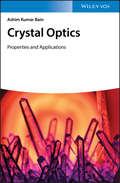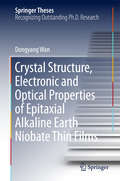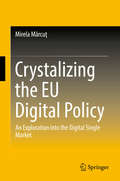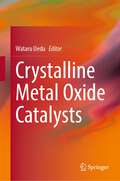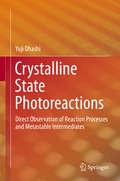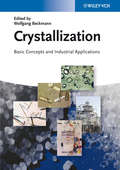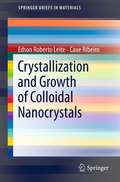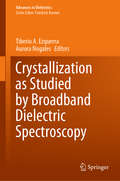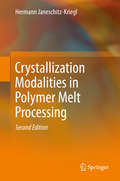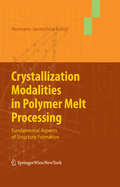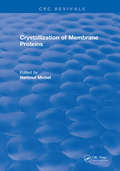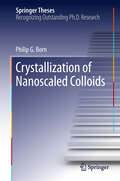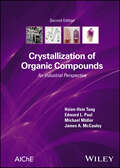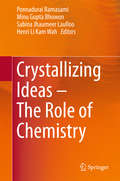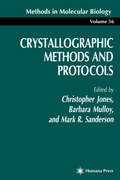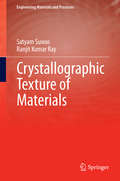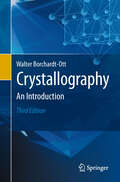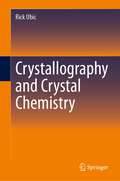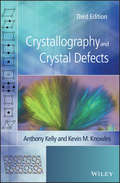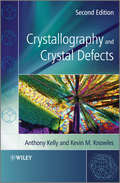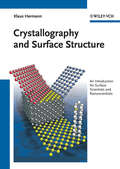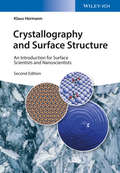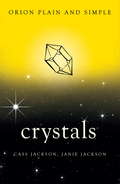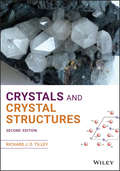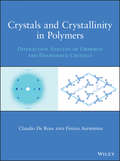- Table View
- List View
Crystal Optics: Properties and Applications
by Ashim Kumar BainReviews the properties and applications of photo-elastic, acousto-optic, magneto-optic, electro-optic, and photorefractive materials This book deals with the basic physical properties and applications of photo-elastic, acousto-optic, magneto-optic, electro-optic, and photorefractive materials. It also provides up-to-date information on the design and applications of various optoelectronic devices based on these materials. The first chapter of Crystal Optics: Properties and Applications covers the basic concepts of crystal optics, such as index ellipsoid or optical indicatrix, crystal symmetry, wave surface, birefringence, and the polarization of light. Chapter 2 reviews the physical phenomena of crystal optics in isotropic and crystalline materials. It describes in detail research information on modern photoelastic materials and reviews the up-to-date photoelastic device applications. Chapter 3 develops the underlying theory of acousto-optics from first principles, formulating results suitable for subsequent calculations and design. The fourth chapter describes the basic principles of magneto-optic effects and mode of interaction with magnetic materials. The fifth chapter provides an understanding of the physical phenomenon of the linear and quadratic electro-optic effects in isotropic and crystalline materials. The last chapter collects many of the most important recent developments in photorefractive effects and materials, and pays special attention to recent scientific findings and advances on photorefractive materials and devices. -Features up to date information on the design and applications of various optoelectronic devices -Looks at the basic concepts of crystal optics, including the polarization of light, effects of reflection and transmission of polarization and light polarizing devices, and more -Pays special attention to design procedures for the entire range of acousto-optic devices and various applications of these devices -Provides research information on modern magneto-optic materials and reviews the up-to-date magneto-optic device applications?up to terahertz (THz) regime Crystal Optics: Properties and Applications is an excellent book for the scientific community working in the field, including researchers, lecturers, and advanced students.
Crystal Structure,Electronic and Optical Properties of Epitaxial Alkaline Earth Niobate Thin Films (Springer Theses)
by Dongyang WanThis impressive thesis offers a comprehensive scientific study of the alkaline earth niobates and describes their nonlinear optical properties for the first time. It explores the crystal structure, electrical properties, optical absorption properties, hot carrier dynamics, nonlinear optical property and strain-induced metal to insulator transition of alkaline earth niobates using advanced experimental techniques. These alkaline earth niobates can have a strong plasmon resonance in the visible range due to their large carrier density, and this unique property gives rise to the emergent phenomenon of photocatalysis and nonlinear optical properties. This series of intrinsic plasmonic materials based on niobates, can be used as a photocatalyst to split water under sunlight, a novel saturable absorber in the high-power ultrashort pulsed laser system, and as a sensor in microelectromechanical systems.
Crystalizing the EU Digital Policy: An Exploration into the Digital Single Market
by Mirela MărcuţThis book explores the intricate connection between the Single Market, characterized by the freedom of movement of goods, services, capital and labor within and across Europe, and the Digital Single Market, the virtual space that promotes freedom of movement of information and data. Both a result and catalyst of the Single Market, the Digital Single Market has become a different space from the Single Market, as the former is based on the application of information and communication technologies (ICTs), while the latter is the result of concerted actions and concessions by Member States in the European Union. The author argues that, similar to the Single Market, the Digital Single Market is an instrument, built by the influence of the Internet, which can provide a new means of socio-economic growth and development in Europe. While sharing many similar characteristics, the Single Market and the Digital Single Market diverge in important aspects, particularly with respect to policy. The research analyzes the interaction between policy actors, their influence in the European decision-making process, and their interests in order to establish a digital policy model, in comparison with market policy. Moreover, this volume considers the implementation process and the success of such initiatives under the current policy model, and puts forward policy recommendations. Ultimately, the author considers the utility of such research on digital policy, considering the current focus on migration, vulnerabilities to internal challenges (e. g. , Brexit) and security threats, maintaining that the discussion of digital policies relates to an innovative vision of the European integration process and prospects for its future.
Crystalline Metal Oxide Catalysts
by Wataru UedaThis book introduces the innovatively advanced crystalline metal oxide catalysts that have multi-catalytic functions on the basis of spatially placed elements in crystal structure. With authors who are experts in their fields, the chapters of the book are organized according to catalytic function, on the basis of crystal structure. The book also covers the structure determination of micro–nano-sized metal oxide crystals that are now standard in most catalytic materials and new trends in catalyst development using materials informatics and catalytic informatics. The information contained here will guide researchers who are eager to carry out sustainable catalytic processes and ultimately to achieve a sustainable society in their quest for catalyst development.
Crystalline State Photoreactions: Direct Observation of Reaction Processes and Metastable Intermediates
by Yuji OhashiThis book focuses on a variety of photochemical reaction processes in the crystalline state. The crystalline state reaction is a new category of solid state reaction, in which a reaction occurs with retention of the single crystal form. The whole reaction processes were observed directly by X-ray and neutron diffractions. In this book, not only the structures of metastable intermediates, such as radicals, carbenes, and nitrenes, but also the unstable species of photochromic compounds and photo-excited structures are shown with colored figures of the molecular structures, with more than 200 figures. The book is an indispensable resource not only for organic, inorganic and physical chemists but also for graduate students, as it furnishes more than 300 references.
Crystallization
by Wolfgang BeckmannCrystallization is a natural occurring process but also a process abundantly used in the industry. Crystallization can occur from a solution, from the melt or via deposition of material from the gas phase (desublimation). Crystals distinguish themself from liquids, gases and amorphous substances by the long-range order of its building blocks that entail the crystals to be formed of well-defined faces, and give rise to a large number of properties of the solid.Crystallization is used at some stage in nearly all process industries as a method of production, purification or recovery of solid materials. Crystallization is practiced on all scales: from the isolation of the first milligrams of a newly synthesized substance in the research laboratory to isolating products on the mulit-million tonne scale in industry. The book describes the breadth of crystallization operations, from isolation from a reaction broth to purification and finally to tailoring product properties.In the first section of the book, the basic mechanisms - nucleation, growth, attrition and agglomeration are introduced. It ensures an understanding of supersaturation, the driving force of crystallization. Furthermore, the solubility of the substance and its dependences on process conditions and the various techniques of crystallization and their possibilities and limitations are discussed. Last but not least, the first part includes an intensive treatment of polymorphism . The second part builds on the basics, exploring how crystallization processes can be developed, either batch-wise or continuous, from solution or from the melt. A discussion of the purification during crystallization serves as a link between the two sections, where practical aspects and an insight using theoretical concepts are combined. Mixing and its influence on thecrystallization as well as the mutual interference of down-stream processes with the crystallization are also treated. Finally, techniques to characterize the crop are discussed.The third part of the book is dedicated to accounts of actual developments and of carried-out crystallizations. Typical pitfalls and strategies to avoid these as well as the design of robust processes are presented.
Crystallization and Growth of Colloidal Nanocrystals (SpringerBriefs in Materials)
by Edson Roberto Leite Caue RibeiroSince the size, shape, and microstructure of nanocrystalline materials strongly impact physical and chemical properties, the development of new synthetic routes to nanocrystals with controlled composition and morphology is a key objective of the nanomaterials community. This objective is dependent on control of the nucleation and growth mechanisms that occur during the synthetic process, which in turn requires a fundamental understanding of both classical nucleation and growth and non-classical growth processes in nanostructured materials. Recently, a novel growth process called Oriented Attachment (OA) was identified which appears to be a fundamental mechanism during the development of nanoscale materials. OA is a special case of aggregation that provides an important route by which nanocrystals grow, defects are formed, and unique--often symmetry-defying--crystal morphologies can be produced. This growth mechanism involves reversible self-assembly of primary nanocrystals followed by reorientation of the assembled nanoparticles to achieve structural accord at the particle-particle interface, the removal of adsorbates and solvent molecules, and, finally, the irreversible formation of chemical bonds to produce new single crystals, twins, and intergrowths. Crystallization and Growth of Colloidal Nanocrystals provides a current understanding of the mechanisms related to nucleation and growth for use in controlling nanocrystal morphology and physical-chemical properties, and is essential reading for any chemist or materials scientist with an interest in using nanocrystals as building blocks for larger structures. This book provides a compendium for the expert reader as well as an excellent introduction for advanced undergraduate and graduate students seeking a gateway into this dynamic area of research.
Crystallization as Studied by Broadband Dielectric Spectroscopy (Advances in Dielectrics)
by Tiberio A. Ezquerra Aurora NogalesThis book presents new approaches that offer a better characterization of the interrelationship between crystalline and amorphous phases. In recent years, the use of dielectric spectroscopy has significantly improved our understanding of crystallization. The combination of modern scattering methods, using either synchrotron light or neutrons and infrared spectroscopy with dielectrics, is now helping to reveal modifications of both crystalline and amorphous phases. In turn, this yields insights into the underlying physics of the crystallization process in various materials, e.g. polymers, liquid crystals and diverse liquids. The book offers an excellent introduction to a valuable application of dielectric spectroscopy, and a helpful guide for every scientist who wants to study crystallization processes by means of dielectric spectroscopy.
Crystallization Modalities in Polymer Melt Processing: Fundamental Aspects Of Structure Formation
by Hermann Janeschitz-KrieglIn addition to structure formation in crystallizing polymers and semicrystalline polymers, this second edition completes the topic of transport phenomena. It also reviews solidification by crystallization during cooling and under flow or pressure, which all play an enormous role in polymer melt processing.Generally, there is an intensive interaction between three transport phenomena: heat transfer, momentum transfer (flow, rheology) and (flow induced) crystallization. The strong interaction between the three transport phenomena is a major challenge when it comes to experimentation, and advances in this area are detailed in the book, guiding further development of sound modeling. This book enables readers to follow an advanced course in polymer processing. It is a valuable resource for polymer chemists, applied physicists, rheologists, plastics engineers, mold makers and material scientists.
Crystallization Modalities in Polymer Melt Processing: Fundamental Aspects of Structure Formation
by Hermann Janeschitz-KrieglThe first book to explicitly focus on the processing of crystallizing polymers, it presents innovative research on diverse interfering processes to help clarify the subject. The first to address the unexpectedly strong interaction of three transport phenomena: heat transfer, momentum transfer (rheology) with crystallization kinetics. With many applications, most well-known crystalline structures are found in polymers like high and low density polyethylene, polypropylene, polybutene and their copolymers. Common problems such as anisotropic shrinkage, warping, and split fiber formation are covered. In addition to applications on amorphous polymers, attempts at numerical simulation on crystallizing polymers are also examined. A feeling for the origins of undesired orientations and frozen-in stresses often associated with the manufacturing process is provided to polymer chemists, applied physicists, rheologists, plastics engineers, mold makers and material scientists.
Crystallization of Membrane Proteins
by Hartmut MichelThe precise knowledge of the structure of biological macromolecules forms the basis of understanding their function and their mechanism of action. It also lays the foundation for rational protein and drug design. The only method to obtain this knowledge is still crystallography. At present, the structures of about 400 proteins are known at or nearly at atomic proteins. However, only two of them are membrane proteins or complexes of the membrane proteins. The reasons for the difference is not the crystals of membrane proteins resists forming special problems when being analysed. The reason is that the membrane proteins resist into forming into well-ordered crystals. The intention of this book is to help to produce well-ordered crystals proteins and to provide guidelines, it is aimed at both biochemists and protein crystallographer‘s.
Crystallization of Nanoscaled Colloids (Springer Theses)
by Philip G. BornThis thesis deals with the processes that create ordered assemblies from disordered nanoparticles. Ordered packings of nanoscale particles can exhibit unusual properties. This work investigates the self-assembly of such particles, a process widely employed for the generation of ordered structures, but not yet well understood. In situ methods are used to observe the assembly of sub-micron polymer lattices and sub-10 nm gold particles into crystalline monolayers and aggregates. On the basis of these results, the book develops new models that describe the competition between different influences, such as thermal agitation and directional forces. It suggests necessary criteria that lead to the emergence of order.
Crystallization of Organic Compounds: An Industrial Perspective
by Hsien-Hsin Tung Edward L. Paul Michael Midler James A. McCauleyCrystallization of Organic Compounds Practical resource covering applications of crystallization principles with methodologies, case studies, and numerous industrial examples for emphasis Based on the authors’ hands-on experiences as process engineers, through the use of case studies and examples of crystallization processes, ranging from laboratory development through manufacturing scale-up, Crystallization of Organic Compounds guides readers through the practical applications of crystallization and emphasizes strategies that have proven to be successful, enabling readers to avoid common pitfalls that can render standard procedures unsuccessful. Most chapters feature multiple examples that guide readers, step by step, through the crystallization of active pharmaceutical ingredients (APIs), including an analysis of the major methods of carrying out crystallization operations, their strengths and potential issues, as well as numerous examples of crystallization processes from development through manufacturing scale. Advancements in the field of crystallization have been integrated throughout the book in the newly revised Second Edition to ensure the content adequately reflects current state-of-the-art industrial know-hows and practice. The new edition also adds chapters addressing downstream operations after the crystallization, including filtration/washing and drying, together with industrial use cases. Crystallization of Organic Compounds includes detailed information on: Solubility and solid behavior, covering phase rule, polymorph, salt/co-crystal, chiral resolution and in-silico solubility prediction; and kinetics, covering seed, supersaturation, nucleation, crystal growth and model-based experimental design Critical issues in the crystallization practice, covering oiling out, seeding/wet-milling, agglomeration/aggregation, mixing scale-up and quality-by-design principles Cooling, anti-solvent, evaporation and reactive crystallization process design, covering batch and continuous operations with industrial examples Special applications, covering crystallization with ultrasound, reaction selectivity enhancement, and computation fluid dynamics, and solid dispersion With highly practical coverage of the subject, Crystallization of Organic Compounds is an essential resource for engineers and chemists involved with the development, scaling, or operation of crystallization process in the pharmaceutical and fine chemical industries, particularly those with degrees in chemical engineering and chemistry.
Crystallizing Ideas - The Role of Chemistry
by Henri Li Kam Wah Ponnadurai Ramasami Minu Gupta Bhowon Sabina Jhaumeer LaullooTwenty-three carefully selected, peer-reviewed contributions from the International Conference on Pure and Applied Chemistry (ICPAC 2014) are featured in this edited book of proceedings. ICPAC 2014, a biennial meeting, was held in Mauritius in June 2014. The theme of the conference was "Crystallizing Ideas: The Role of Chemistry" and it matched the declaration of the year 2014 as the International Year of Crystallography. ICPAC 2014 was attended by 150 participants from 30 countries. The chapters in this book reflect a wide range of fundamental and applied research in chemistry and interdisciplinary subjects. Crystallizing Ideas - The Role of Chemistry is written for graduates, postgraduates, researchers in industry and academia who have an interest in the fields ranging from fundamental to applied chemistry.
Crystallographic Methods and Protocols (Methods in Molecular Biology #56)
by Christopher Jones Barbara Mulloy Mark R. SandersonIn Crystallographic Methods and Protocols leading specialists in the application of X-ray crystallography to biological problems provide a basic and comprehensive guide to its successful use in obtaining detailed three-dimensional structures of proteins, nucleic acids, and their complexes. These deeply experienced researchers describe in clear practical terms their proven methods for preparing samples, crystallizing them, obtaining preliminary characterizations, acquiring and analyzing data, and solving and refining structures. Their step-by-step instructions give biologically trained workers immediate access to a powerful technique essential to solving many biologically relevant problems.
Crystallographic Texture of Materials (Engineering Materials and Processes)
by Satyam Suwas Ranjit Kumar RayProviding a comprehensive and invaluable overview of the basics of crystallographic textures and their industrial applications, this book covers a broad range of both structural and functional materials. It introduces the existing methods of representation in an accessible manner and presents a thorough overview of existing knowledge on texture of metallic materials. Texture analysis has widespread use in many industries, and provides crucial input towards the development of new materials and products. There has been rapid growth in the science and art of texture analysis in the last few decades. Other topics addressed within this book include recent research on texture in thin films and non-metals, and the dependence of material properties on texture, and texture control in some engineering materials. This book constitutes an invaluable reference text for researchers and professionals working on texture analysis in metallurgy, materials science and engineering, physics and geology. By using content selectively, it is also highly accessible to undergraduate students.
Crystallography: An Introduction
by Walter Borchardt-Ott Robert O. GouldAs a self-study guide, course primer or teaching aid, Borchardt-Ott's Crystallography is the perfect textbook for students and teachers alike. In fact, it can be used by crystallographers, chemists, mineralogists, geologists and physicists. Based on the author's more than 25 years of teaching experience, the book has numerous line drawings designed especially for the text and a large number of exercises - with solutions - at the end of each chapter. This 3rd edition is the translation of the seventh German edition with new chapters focused on crystal chemistry and x-ray diffraction methods.
Crystallography and Crystal Chemistry
by Rick UbicThis textbook introduces readers to the language, concepts, and tools of crystallography, as well as many aspects of crystal chemistry. Important topics, such as bonding, electronegativity, lattice energy, symmetry operations, crystal defects, and structure-property relationships are covered. Worked examples are included where appropriate. By uniquely combining elements of crystallography and crystal chemistry, the text is a useful and accessible resource for students across many disciplines. Chapter summaries and example problems are included to optimize use by students and faculty in both graduate and undergraduate curricula. Historical context to relevant discoveries and biographical sketches of many of the scientists involved in the development of this field are also provided to expand the student’s knowledge of both solid-state science and scientists.
Crystallography and Crystal Defects
by Anthony Kelly Kevin M. KnowlesThe classic book that presents a unified approach to crystallography and the defects found within crystals, revised and updated This new edition of Crystallography and Crystal Defects explains the modern concepts of crystallography in a clear, succinct manner and shows how to apply these concepts in the analyses of point, line and planar defects in crystalline materials. Fully revised and updated, this book now includes: Original source references to key crystallographic terms familiar to materials scientists Expanded discussion on the elasticity of cubic materials New content on texture that contains more detail on Euler angles, orientation distribution functions and an expanded discussion on examples of textures in engineering materials Additional content on dislocations in materials of symmetry lower than cubic An expanded discussion of twinning which includes the description and classification of growth twins The inclusion and explanation of results from atomistic modelling of twin boundaries Problem sets with new questions, detailed worked solutions, supplementary lecture material and online computer programs for crystallographic calculations. Written by authors with extensive lecturing experience at undergraduate level, Crystallography and Crystal Defects, Third Edition continues to take its place as the core text on the topic and provides the essential resource for students and researchers in metallurgy, materials science, physics, chemistry, electrical, civil and mechanical engineering.
Crystallography and Crystal Defects
by Kevin M. Knowles Anthony A. KellyExtensively revised and updated, this new edition of a classic text presents a unified approach to crystallography and to the defects found within crystals. The book combines the classical and exact description of symmetry of a perfect crystal with the possible geometries of the major defects-dislocations, stacking faults, point defects, twins, interfaces and the effects of martensitic transformations. A number of important concepts and exciting new topics have been introduced in this second edition, including piezoelectricity, liquid crystals, nanocrystalline concepts, incommensurate materials and the structure of foamed and amorphous solids. The coverage of quasicrystalline materials has been extended, and the data tables, appendices and references have been fully updated.Reinforcing its unrivalled position as the core text for teaching crystallography and crystal defects, each chapter includes problem sets with brief numerical solutions at the end of the book. Detailed worked solutions, supplementary lecture material and computer programs for crystallographic calculations are provided online (http://booksupport.wiley.com).
Crystallography and Surface Structure: An Introduction for Surface Scientists and Nanoscientists
by Klaus HermannA valuable learning tool as well as a reference, this book provides students and researchers in surface science and nanoscience with the theoretical crystallographic foundations, which are necessary to understand local geometries and symmetries of bulk crystals, including ideal single crystal surfaces. The author deals with the subject at an introductory yet mathematically sound level, providing numerous graphic examples to keep the math in context. The book brings together and logically connects many seemingly disparate structural issues and notations used frequently by surface scientists and nanoscientists. Numerous exercises of varying difficulty, ranging from simple questions to small research projects, are included to stimulate discussions about the different subjects.
Crystallography and Surface Structure: An Introduction For Service Scientists And Nanoscientists
by Klaus HermannA valuable learning tool as well as a reference, this book provides students and researchers in surface science and nanoscience with the theoretical crystallographic foundations, which are necessary to understand local structure and symmetry of bulk crystals, including ideal and real single crystal surfaces. The author deals with the subject at an introductory level, providing numerous graphic examples to illustrate the mathematical formalism. The book brings together and logically connects many seemingly disparate structural issues and notations used frequently by surface scientists and nanoscientists. Numerous exercises of varying difficulty, ranging from simple questions to small research projects, are included to stimulate discussions about the different subjects. From the contents: Bulk Crystals, Three-Dimensional Lattices - Crystal Layers, Two-Dimensional Lattices, Symmetry - Ideal Single Crystal Surfaces - Real Crystal Surfaces - Adsorbate layers - Interference Lattices - Chiral Surfaces - Experimental Analysis of Real Crystal Surfaces - Nanoparticles and Crystallites - Quasicrystals - Nanotubes
Crystals: The Only Book You'll Ever Need (Plain And Simple Ser.)
by Cass Jackson & Janie JacksonFrom time immemorial, crystals have been used for healing, and legend has it that long ago, people knew how to store information inside these precious stones. How does their incredible magic work? Through this clear, practical guide, discover the many ways crystals can cure physical, emotional, and spiritual problems, divine the future, and enhance psychic powers. See which ones work best to aid meditation and visualisation, clear a room of negative energy, promote creativity, or foresee the future. There's advice on buying, purifying, and charging the stones, crystal folklore, and a breath-taking gallery rich in information.
Crystals and Crystal Structures
by Richard J. TilleyAn authoritative, updated text that offers an introduction to crystals and crystal structure with coverage of crystallography, and microscopy of materials Written in a friendly, non-mathematical style, the updated second edition of Crystals and Crystal Structures offers a comprehensive exploration of the key elements of crystals and crystal structures. Starting with the basics, it includes information on multiple areas of crystallography, including modulated structures, quasicrystals and protein crystallography, and interdisciplinary applications as diverse as the relationship between physical properties and symmetry. To enhance comprehension of the material presented, the book contains a variety of problems and exercises. The revised second edition offers new material and updates in the field including: An introduction to the use of high intensity X-ray analysis of protein structures Advances in imaging, scanning electron microscopy, and cryo-electron microscopy The relationship between symmetry and physical properties highlighting new findings and an introduction to tensor notation in describing these relationships in a concise fashion Nanoparticles as well as crystallographic aspects, defects, surface defects and the impact of these crystallographic features on properties Perovskite structures and their variations and the inclusion of their wide-ranging properties Written for students ofcrystallography, chemistry, physics, materials science, biosciences and geology, Crystals and Crystal Structures, Second Edition provides an understanding of the subject and enables students to read scientific papers and articles describing a crystal structure or use crystallographic databases.
Crystals and Crystallinity in Polymers
by Finizia Auriemma Claudio De RosaProvides the tools needed to master and apply the fundamentals of polymer crystallographyUsing core concepts in physics, chemistry, polymer science and engineering, this book sheds new light on the complex field of polymer crystallography, enabling readers to evaluate polymer crystallization data and determine the best methods to use for their investigations. The authors set forth a variety of tested and proven methods for analyzing ordered and disordered structures in polymer crystals, including X-ray diffraction, electron diffraction, and microscopy. In addition to the basics, the book explores several advanced and emerging topics in the field such as symmetry breaking, frustration, and the principle of density-driven phase formation.Crystals and Crystallinity in Polymers introduces two new concepts in crystallinity and crystals in synthetic polymers. First, crystallinity in polymeric materials is compatible with the absence of true three-dimensional long-range order. Second, the disorder may be described as a structural feature, using the methods of X-ray scattering and electron diffraction analysis.The book begins by introducing the basic principles and methods for building structural models for the conformation of polymer crystal chains. Next, it covers:Packing of macromolecules in polymer crystalsMethods for extracting structural parameters from diffraction dataDefects and disorder in polymer crystalsAnalytical methods for diffuse scattering from disordered polymer structuresCrystal habitInfluence of crystal defects and structural disorder on the physical and mechanical properties of polymeric materialsCrystals and Crystallinity in Polymers examines all the possible types of structural disorder generally present in polymer crystals and describes the influence of each kind of disorder on X-ray and electron diffraction patterns. Its comprehensive, expert coverage makes it possible for readers to learn and apply the fundamentals of polymer crystallography to solve a broad range of problems.
